Cyrtophora
Cyrtophora, the tent-web spiders, is a genus of orb-weaver spiders first described by Eugène Simon in 1895.[2] Although they are in the "orb weaver" family, they do not build orb webs. Their tent-like, highly complex non-sticky web is sometimes considered a precursor of the simplified orb web. These webs are aligned horizontally, with a network of supporting threads above them. These spiders often live in colonies. Females have a body length of mostly about 10 millimetres (0.39 in) long. Some members, including Cyrtophora cicatrosa, exhibit the ability to change colour rapidly.[3]
| Tent-web spider | |
|---|---|
 | |
| Green tent-web spider | |
 | |
| Cyrtophora moluccensis suspended beneath its web | |
| Scientific classification | |
| Kingdom: | Animalia |
| Phylum: | Arthropoda |
| Subphylum: | Chelicerata |
| Class: | Arachnida |
| Order: | Araneae |
| Infraorder: | Araneomorphae |
| Family: | Araneidae |
| Subfamily: | Cyrtophorinae |
| Genus: | Cyrtophora Simon, 1864 |
| Type species | |
| C. citricola (Forsskål, 1775) | |
| Species | |
|
53, see text | |
| Synonyms[1] | |
| |
A kleptoparasitic spider (Argyrodes fissifrons) was found to live in a mutualistic relationships with Cyrtophora species.[4][5] Some of the species are considered social spiders, building large structures where the territories of the offspring are built along the margin of the mothers web.[6]
Species
As of April 2019 it contains fifty-three species:[1]
- C. admiralia Strand, 1913 – Admiralty Is.
- C. beccarii (Thorell, 1878) – Laos, Malaysia to Australia (Northern Territory)
- C. bicauda (Saito, 1933) – Taiwan
- C. bidenta Tikader, 1970 – India
- C. bimaculata Han, Zhang & Zhu, 2010 – China
- C. bituberculata Roy, Saha & Raychaudhuri, 2017 – India
- C. caudata Bösenberg & Lenz, 1895 – East Africa
- C. cephalotes Simon, 1877 – Philippines
- C. cicatrosa (Stoliczka, 1869) – Pakistan to Australia (Northern Territory)
- C. citricola (Forsskål, 1775) – Southern Europe, Africa, Middle East, Pakistan, India, China, Japan. Introduced to Dominican Rep., Costa Rica, Colombia, Brazil[7]
- Cyrtophora c. abessinensis Strand, 1906 – Ethiopia
- Cyrtophora c. lurida Karsch, 1879 – West Africa
- Cyrtophora c. minahassae Merian, 1911 – Indonesia (Sulawesi)
- C. cordiformis (L. Koch, 1871) – New Guinea, Australia (Queensland, Lord Howe Is.)
- C. crassipes (Rainbow, 1897) – Australia (New South Wales)
- C. cylindroides (Walckenaer, 1841) – China to Australia (Queensland)
- Cyrtophora c. scalaris Strand, 1915 – Papua New Guinea (New Britain)
- C. diazoma (Thorell, 1890) – Indonesia (Sumatra)
- C. doriae (Thorell, 1881) – New Guinea, Papua New Guinea (Bismarck Arch.)
- C. eczematica (Thorell, 1892) – Malaysia, Indonesia (Java, Sulawesi), New Guinea
- C. exanthematica (Doleschall, 1859) – Myanmar to Philippines, Australia (New South Wales)
- C. feae (Thorell, 1887) – India to Myanmar
- C. forbesi (Thorell, 1890) – Indonesia (Sumatra)
- C. gazellae (Karsch, 1878) – Papua New Guinea (New Britain)
- C. gemmosa Thorell, 1899 – Cameroon
- C. guangxiensis Yin, Wang, Xie & Peng, 1990 – China
- C. hainanensis Yin, Wang, Xie & Peng, 1990 – China
- C. hirta L. Koch, 1872 – Australia (Queensland, New South Wales)
- C. ikomosanensis (Bösenberg & Strand, 1906) – Taiwan, Japan
- C. jabalpurensis Gajbe & Gajbe, 1999 – India
- C. koronadalensis Barrion & Litsinger, 1995 – Philippines
- C. ksudra Sherriffs, 1928 – India
- C. lacunaris Yin, Wang, Xie & Peng, 1990 – China
- C. lahirii Biswas & Raychaudhuri, 2004 – Bangladesh
- C. larinioides Simon, 1895 – Cameroon
- C. limbata (Thorell, 1898) – Myanmar
- C. lineata Kulczyński, 1910 – Solomon Is., Bismarck Arch.
- C. moluccensis (Doleschall, 1857) – India to Japan, Indonesia, Papua New Guinea, Australia, Fiji, Tonga, French Polynesia
- Cyrtophora m. albidinota Strand, 1911 – Caroline Is., Palau Is., Yap Is.
- Cyrtophora m. bukae Strand, 1911 – Solomon Is.
- Cyrtophora m. cupidinea (Thorell, 1875) – New Caledonia
- Cyrtophora m. margaritacea (Doleschall, 1859) – Indonesia (Java)
- Cyrtophora m. rubicundinota Strand, 1911 – Papua New Guinea (Keile Is.)
- C. monulfi Chrysanthus, 1960 – New Guinea, Australia (Northern Territory)
- C. nareshi Biswas & Raychaudhuri, 2004 – Bangladesh
- C. parangexanthematica Barrion & Litsinger, 1995 – Philippines
- C. parnasia L. Koch, 1872 – Australia, Tasmania
- C. petersi Karsch, 1878 – Mozambique
- C. rainbowi (Roewer, 1955) – Australia (New South Wales)
- C. sextuberculata Tanikawa & Petcharad, 2015 – Thailand
- C. subacalypha (Simon, 1882) – Yemen
- C. trigona (L. Koch, 1871) – Australia (Queensland), New Guinea
- C. unicolor (Doleschall, 1857) – India, Sri Lanka to Japan, Philippines, New Guinea, Australia (Christmas Is.)
References
- "Gen. Cyrtophora Simon, 1864". World Spider Catalog. Natural History Museum Bern. Retrieved 2019-05-13.
- Simon, E (1895). Histoire naturelle des araignées. doi:10.5962/bhl.title.51973.
- "Spider Ecology". Earth-Life Web Productions.
- Tso, I.M.; Severinghaus, L.L. (2000). "Argyrodes fissifrons inhabiting webs of Cyrtophora hosts: Prey size distribution and population characteristics" (PDF). Zoological Studies. 39: 236–242.
- Peng, P; Blamires, SJ; Agnarsson, I; Lin, HC; Tso, IM (2013). "A color-mediated mutualism between two arthropod predators". Curr. Biol. 23: 172–176. doi:10.1016/j.cub.2012.11.057. PMID 23260470.
- Downes, M.F. (1995). "Australasian sodal spiders: what is meant by 'soda!'?" (PDF). Records of the Western Australian Museum. 52: 25–32. Retrieved 2017-09-21.
- Álvares, É.S.S.; De Maria, M. (2004). "First record of Cyrtophora citricola (Forskål) in Brazil (Araneae, Araneidae)" (PDF). Revista Brasileira de Zoologia. 21 (1): 155–156. doi:10.1590/S0101-81752004000100026.
External links
| Wikimedia Commons has media related to Cyrtophora. |